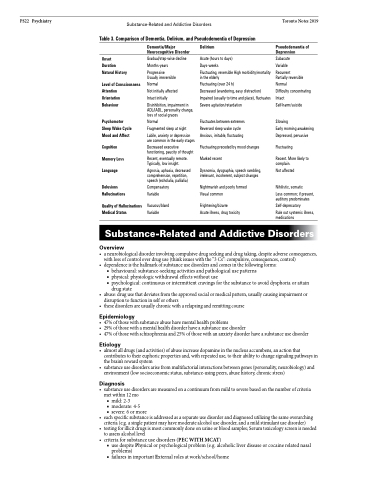Page 1186 - TNFlipTest
P. 1186
PS22 Psychiatry
Substance-Related and Addictive Disorders
Toronto Notes 2019
Table 3. Comparison of Dementia, Delirium, and Pseudodementia of Depression
Onset
Duration Natural History
Level of Consciousness Attention
Orientation
Behaviour
Psychomotor Sleep Wake Cycle Mood and Affect
Cognition Memory Loss Language
Delusions Hallucinations
Quality of Hallucinations Medical Status
Dementia/Major Neurocognitive Disorder
Gradual/step-wise decline Months-years
Progressive Usually irreversible
Normal
Not initially affected
Intact initially
Disinhibition, impairment in ADL/IADL, personality change, loss of social graces
Normal
Fragmented sleep at night
Labile, anxiety or depression are common in the early stages
Decreased executive functioning, paucity of thought
Recent, eventually remote. Typically, low insight.
Agnosia, aphasia, decreased comprehension, repetition, speech (echolalia, palilalia)
Compensatory Variable
Vacuous/bland Variable
Delirium
Acute (hours to days) Days-weeks
Fluctuating, reversible High morbidity/mortality in the elderly
Fluctuating (over 24 h)
Decreased (wandering, easy distraction) Impaired (usually to time and place), fluctuates Severe agitation/retardation
Fluctuates between extremes Reversed sleep wake cycle Anxious, irritable, fluctuating
Fluctuating preceded by mood changes Marked recent
Dysnomia, dysgraphia, speech rambling, irrelevant, incoherent, subject changes
Nightmarish and poorly formed Visual common
Frightening/bizarre
Acute illness, drug toxicity
Pseudodementia of Depression
Subacute Variable
Recurrent Partially reversible
Normal
Difficulty concentrating Intact Self-harm/suicide
Slowing
Early morning awakening Depressed, pervasive
Fluctuating
Recent. More likely to complain.
Not affected
Nihilistic, somatic
Less common; if present, auditory predominates
Self-deprecatory
Rule out systemic illness, medications
Substance-Related and Addictive Disorders
Overview
• aneurobiologicaldisorderinvolvingcompulsivedrugseekinganddrugtaking,despiteadverseconsequences, with loss of control over drug use (think issues with the “3 Cs”: compulsive, consequences, control)
• dependenceisthehallmarkofsubstanceusedisordersandcomesinthefollowingforms:
■ behavioural: substance-seeking activities and pathological use patterns
■ physical: physiologic withdrawal effects without use
■ psychological: continuous or intermittent cravings for the substance to avoid dysphoria or attain
drug state
• abuse:drugusethatdeviatesfromtheapprovedsocialormedicalpattern,usuallycausingimpairmentor
disruption to function in self or others
• thesedisordersareusuallychronicwitharelapsingandremittingcourse
Epidemiology
• 47%ofthosewithsubstanceabusehavementalhealthproblems
• 29%ofthosewithamentalhealthdisorderhaveasubstanceusedisorder
• 47%ofthosewithschizophreniaand25%ofthosewithananxietydisorderhaveasubstanceusedisorder
Etiology
• almostalldrugs(andactivities)ofabuseincreasedopamineinthenucleusaccumbens,anactionthat contributes to their euphoric properties and, with repeated use, to their ability to change signaling pathways in the brain’s reward system
• substanceusedisordersarisefrommultifactorialinteractionsbetweengenes(personality,neurobiology)and environment (low socioeconomic status, substance-using peers, abuse history, chronic stress)
Diagnosis
• substanceusedisordersaremeasuredonacontinuumfrommildtoseverebasedonthenumberofcriteria met within 12 mo
■ mild: 2-3
■ moderate: 4-5
■ severe: 6 or more
• eachspecificsubstanceisaddressedasaseparateusedisorderanddiagnosedutilizingthesameoverarching criteria (e.g. a single patient may have moderate alcohol use disorder, and a mild stimulant use disorder)
• testingforillicitdrugsismostcommonlydoneonurineorbloodsamples;Serumtoxicologyscreenisneeded to assess alcohol level
• criteriaforsubstanceusedisorders(PECWITHMCAT)
■ use despite Physical or psychological problem (e.g. alcoholic liver disease or cocaine related nasal
problems)
■ failures in important External roles at work/school/home


